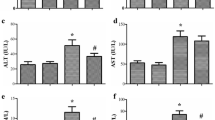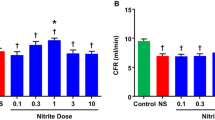Abstract
Objective
Decreased diaphragmatic contractility and organ failure observed during sepsis is mediated by an overproduction of nitric oxide (.NO)-derived species, mitochondria being a major target of oxidative and nitrative stress. We tested the potential protective effects of (a) a novel synthetic antioxidant, the manganese(III) 5,10,15,20-tetrakis(N-ethylpyridinium-2-yl) porphyrin (MnTE-2-PyP5+) and (b) the inducible .NO synthase inhibitor aminoguanidine (AG) on a rat model of sepsis.
Setting
University research laboratories.
Subjects and interventions
Sepsis was induced by cecal ligation and perforation in rats.
Measurements and results
Systemic hemodynamics, pulmonary gas exchange, in vitro diaphragmatic function and mitochondrial respiration were evaluated. Moreover, plasma and mitochondrial oxidative and nitrative stress parameters were investigated. Sepsis determined diaphragmatic dysfunction and a significant decrease in mitochondrial coupling and respiration. Oxidative stress was evidenced by decreased plasma antioxidants and increased lipid oxidation. Tyrosine nitration was increased in the plasma and mitochondria of the septic animals. These alterations were ameliorated or prevented by either MnTE-2-PyP5+ or AG.
Conclusions
Our results demonstrate that overproduction of .NO and .NO-derived reactive species play a critical role in mitochondrial impairment and diaphragmatic function during sepsis. More importantly, AG but mainly the novel metalloporphyrin MnTE-2-PyP5+ were able to ameliorate diaphragmatic and mitochondrial dysfunction and could contribute to preventing organ failure during severe sepsis.


Similar content being viewed by others
References
Bone RC, Grodzin CJ, Balk RA (1997) Sepsis: a new hypothesis for pathogenesis of the disease process. Chest 112:235–243
Wheeler AP, Bernard GR (1999) Treating patients with severe sepsis. N Engl J Med 340:207–214
Hussain SN (1998) Respiratory muscle dysfunction in sepsis. Mol Cell Biochem 179:125–134
Hussain SN, Simkus G, Roussos C (1985) Respiratory muscle fatigue: a cause of ventilatory muscle failure in septic shock. J Appl Physiol 58:2033–2040
Callahan LA, Stofan DA, Szweda LI, Nethery DE, Supinski GS (2001) Free radicals alter maximal diaphragmatic mitochondrial oxygen consumption in endotoxin-induce sepsis. Free Radic Biol Med 30:129–138
Lanone S, Mebazaa A, Heymes C, Henin D, Poderoso JJ, Panis Y, Zedda C, Billiar T, Payen D, Aubier M, Boczkowski J (2000) Muscular contractile failure in septic patients: role of the inducible nitric oxide synthase pathway. Am J Respir Crit Care Med 162:2308–2315
Fijimura N, Sumita S, Aimono M, Masuda Y, Shichinohe Y, Naritmatsu E, Namiki A (2000) Effect of free radical scavengers on diaphragmatic contractility in septic peritonitis. Am J Respir Crit Care Med 162:2159–2165
Fijimura N, Sumita S, Narimatsu E (2000) Alteration in diaphragmatic contractility during septic peritonitis in rats: effect of polyethylene glycol-absorbed superoxide dismutase. Crit Care Med 28:2406–2414
Lin MC, Ebihara S, El Dwairi Q, Hussain SN, Yang L, Gottfried SB, Comtois A, Petrof BJ (1998) Diaphragm sarcolemmal injury is induced by sepsis and alleviated by nitric oxide synthase inhibition. Am J Respir Crit Care Med 158:1656–1663
Supinski G, Stofan D, Callahan LA, Nethery D, Nosek TM, DiMarco A (1999) Peroxynitrite induces contractile dysfunction and lipid peroxidation in the diaphragm. J Appl Physiol 87:783–791
Supinski G, Nethery D, Stofan D, DiMarco A (1997) Effect of free radical scavengers on diaphragmatic fatigue. Am J Respir Crit Care Med 155:622–629
Goode HF, Cowley HC, Walker BE, Howdle PD, Webster NR (1995) Decreased antioxidant status and increased lipid peroxidation in patients with septic shock and secondary organ dysfunction. Crit Care Med 23:646–651
Armour J, Tyml K, Lidington D, Wilson JX (2001) Ascorbate prevents microvascular dysfunction in skeletal muscle of the septic rat. J Appl Physiol 90:795–803
Galley HF, Howdle PD, Walker BE, Webster NR (1997) The effects of intravenous antioxidants in patients with septic shock. Free Radic Biol Med 23:768–774
Radi R, Denicola A, Ferrer G, Alvarez B, Rubbo H (2000) The biological chemistry of peroxynitrite. In: L. Ignaro (ed) Nitric oxide. Biology and pathobiology. Advances in Pharmacology. Academic Press, San Diego, CA, pp 57–82
Radi R, Peluffo G, Alvarez MN, Naviliat M, Cayota A (2001) Unraveling peroxynitrite formation in biological systems. Free Radic Biol Med 30:463–488
Radi R, Cassina A, Hodara R, Quijano C, Castro L (2002) Peroxynitrite reactions and formation in mitochondria. Free Radic Biol Med 33:1451–1464
Boczkowski J, Lisdero CL, Lanone S, Samb A, Carreras M, Boveris A, Aubier M, Poderoso JJ (1999) Endogenous peroxynitrite mediates mitochondrial dysfunction in rat diaphragm during endotoxemia. FASEB J 13:1637–1647
Brealey D, Brand M, Hargreaves I, Heales S, Land J, Smolenski R, Davies NA, Cooper CE, Singer M (2002) Association between mitochondrial dysfunction and severity and outcome of septic shock. Lancet 360:219–223
Radi R, Cassina A, Hodara R (2002) Nitric oxide and peroxynitrite interactions with mitochondria. Biol Chem 383:401–409
Radi R, Rodriguez M, Castro L, Telleri R (1994) Inhibition of mitochondrial electron transport by peroxynitrite. Arch Biochem Biophys 308:89–95
Ferrer-Sueta G, Quijano C, Alvarez B, Radi R (2002) Reactions of manganese porphyrins and manganese-superoxide dismutase with peroxynitrite. Methods Enzymol 349:23–37
Ferrer-Sueta G, Batinic-Haberge I, Spasojevic I, Fridovich I, Radi R (1999) Catalytic scavenging of peroxynitrite by isomeric Mn(III) N-methylpyridylporphyrins in the presence of reductants. Chem Res Toxicol 1999 12:442–449
Wichterman KA, Baue AE, Chaudry IH (1990) Sepsis and septic shock: a review of laboratory models and a proposal. J Surg Res 29:189–201
Fink MP, Heard SO (1990) Laboratory models of sepsis and septic shock. J Surg Res 49:186–196
Cassina A, Radi R (1996) Differential inhibitory action of nitric oxide and peroxynitrite on mitochondrial electron transport. Arch Biochem Biophys 328:309–316
Teissier E, Walters-Laporte E, Duhem C, Luc G, Fruchart JC, Duriez P (1996) Rapid quantification of alpha-tocopherol in plasma and low- and high-density lipoproteins. Clin Chem 42:430–435
Mohr D, Stocker R (1996) Selective and sensitive measurement of vitamin C, ubiquinol and other low-molecular weight antioxidants. In: Punchard NA, Kelly J (eds) Free radicals: a practical approach. Oxford University Press, New York, pp 271–285
Trostchansky A, Batthyany C, Botti H, Radi R, Denicola A, Rubbo H (2001) Formation of lipid-protein adducts in low-density lipoprotein by fluxes of peroxynitrite and its inhibition by nitric oxide. Arch Biochem Biophys 395:225–232
Miranda KM, Espey MG, Wink DA (2001) A rapid, simple spectrophotometric method for simultaneous detection of nitrate and nitrite. Nitric Oxide 5:62–71
Cassina AM, Hodara R, Souza JM, Thomson L, Castro L, Ischiropoulos H, Freeman BA, Radi R (2000) Cytochrome c nitration by peroxynitrite. J Biol Chem 275:21409–21415
Brito C, Naviliat M, Tiscornia AC, Vuillier F, Gualco G, Dighiero G, Radi R, Cayota AM (1999) Peroxynitrite inhibits T lymphocyte activation and proliferation by promoting impairment of tyrosine phosphorylation and peroxynitrite-driven apoptotic death. J Immunol 162:3356–3366
Hurtado FJ, Gutierrez AM, Silva N, Fernandez E, Khan AE, Gutierrez G (1992) Role of tissue hypoxia as the mechanism of lactic acidosis during E. coli endotoxemia. J Appl Physiol 72:1895–1901
Gutierrez G, Hurtado FJ, Fernandez E (1995) Inhibitory effects of Escherichia coli endotoxin on skeletal muscle contractility. Crit Care Med 23:308–315
Boulos M, Astiz ME, Barua RS, Osman M (2003) Impaired mitochondrial function induced by serum from septic shock patients is attenuated by inhibition of nitric oxide synthase and poly (ADP-ribose) synthase. Crit Care Med 31:353–358
Aulak KS, Miyagi M, Yan L, West KA, Massillon D, Crabb JW, Stuehr DJ (2001) Proteomic method identifies proteins nitrated in vivo during inflammatory challenge. Proc Natl Acad Sci 98:12056–12061
Elfering SL, Haynes VL, Traaseth NJ, Ettl A, Giulivi C (2004) Aspects, mechanisms and biological relevance of mitochondrial protein nitration sustained by mitochondrial nitric oxide synthase. Am J Physiol Heart Circ Physiol 286:H22–H29
Sambe A, Ungureaneu-Longrois D, Danialou G, Lanone S, Benessiano J, Aubier M, Boczkowski J (1998) Role of nitric oxide on diaphragmatic contractile failure in Escherichia coli endotoxemic rats. Comp Biochem Physiol A Mol Integr Physiol 119:167–175
Mikawa K, Kodama SI, Nishina K, Obara H (2001) ONO-1714, a new inducible nitric oxide synthase inhibitor, attenuates diaphragmatic dysfunction associated with cerulein-induced pancreatitis in rats. Crit Care Med 29:1215–1221
Ebihara S, Hussain SN, Danialou G, Cho WK, Gottfried SB, Petrof BJ (2002) Mechanical ventilation protects against diaphragm injury in sepsis. Interactions of oxidative and mechanical stresses. Am J Respir Crit Care Med 165:221–228
Giardino I, Fard A, Hatchell D and Brownlee M (1998) Aminoguanidine inhibits reactive oxygen species formation, lipid peroxidation and oxidant-induced apoptosis. Diabetes 47:1114–1120
Chen A, Taguchi T, Aoyama A, Sugiura M, Haruna M, Wang M, Miwa I (2003) Antioxidant activity of a Schiff base of pyridoxal and aminoguanidine. Free Radic Biol Med 35:1392–1403
Salvemini D, Cuzzocrea S (2003) Therapeutic potential of superoxide dismutase mimetics as therapeutic agents in critical care medicine. Crit Care Med 31(Suppl):S29–S38
Wang W, Jittikanont S, Falk SA, Li P, Feng L, Gengaro PE, Poole BD, Bowler RP, Day BJ, Crapo JD, Schrier RW (2002) Interaction among nitric oxide, reactive oxygen species and antioxidants during endotoxemia-related acute renal failure. Am J Physiol Renal Physiol 284:F532–F537
Sheng H, Enghild JJ, Bowler R, Patel M, Batinic-Haberle I, Calvi CL, Day BJ, Pearlstein RD, Crapo JD, Warner DS (2002) Effects of metalloporphyrin catalytic antioxidants in experimental brain ischemia. Free Radic Biol Med 33:947–961
Kettle AJ, van Dalen CJ, Winterbourn CC (1997) Peroxynitrite and myeloperoxidase leave the same footprint in protein nitration. Redox Rep 3:257–258
Eiserich JP, Hristova M, Cross CE, Jones AD, Freeman BA, Halliwell B, van der Vliet A (1998) Formation of nitric oxide-derived inflammatory oxidants by myeloperoxidase in neutrophils. Nature 391:393–397
Baldus S, Eiserich JP, Brennan ML, Jackson RM, Alexander CB, Freeman BA (2002) Spatial mapping of pulmonary and vascular nitrotyrosine reveals the pivotal role of myeloperoxidase as a catalyst for tyrosine nitration in inflammatory diseases. Free Radic Biol Med. 33:1010
Acknowledgements
We thank Ines Batinic-Haberle from Duke University for providing the MnTE-2-PyP5+.
Author information
Authors and Affiliations
Corresponding author
Additional information
This work was supported in part by FOGARTY-NIH, Wellcome Trust and Guggenheim Foundation for Homero Rubbo and Rafael Radi, and the Howard Hughes Medical Institute for Rafael Radi, and by PRONBIO, Fundación Manuel Pérez for Nicolás Nin.
Rights and permissions
About this article
Cite this article
Nin, N., Cassina, A., Boggia, J. et al. Septic diaphragmatic dysfunction is prevented by Mn(III)porphyrin therapy and inducible nitric oxide synthase inhibition. Intensive Care Med 30, 2271–2278 (2004). https://doi.org/10.1007/s00134-004-2427-x
Received:
Accepted:
Published:
Issue Date:
DOI: https://doi.org/10.1007/s00134-004-2427-x




